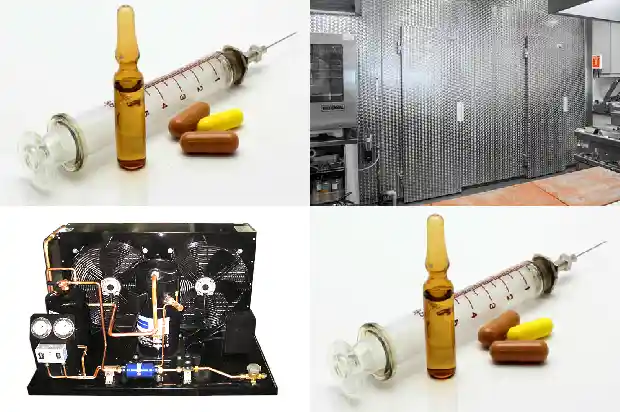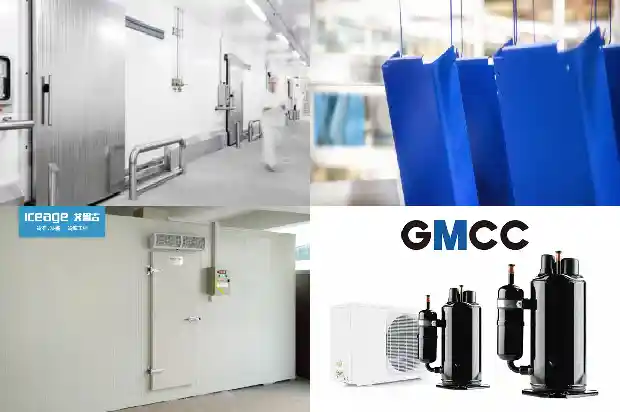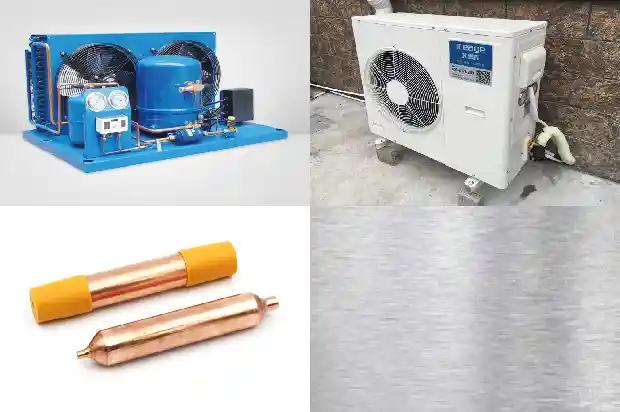Do You Have a Thorough Grasp of All 34 Components and Functions of the Air-Cooled Multi-Split System?
2025-03-01
The multi-split system is commonly known as "one-to-many", which means that one outdoor unit is connected to two or more indoor units through piping.

The central air conditioning of the multi-split system solves the situation where all units of the traditional central air conditioning are turned on at the same time. It can control the activation of indoor units more intelligently, which not only facilitates people's lives but also greatly saves energy consumption.
- Analysis of the Advantages and Disadvantages of the Multi-Split System
Advantages: - There are fewer outdoor units, which will not affect the appearance of the building.

- The construction cost is lower than that of water-cooled units, and the operating cost is also relatively low.
- The control is flexible, and some brands can even achieve remote control through a telephone and a modem.
- The noise is relatively low, and the operation is quiet.
- The installation is simple, no three-phase power supply is required, and the construction period is short.
Disadvantages: - There are limitations on the length of the refrigerant pipes and the height difference between the indoor and outdoor units, so it is not suitable for rooms with a large depth.
- The external static pressure of the unit is small, and the air supply distance is short.
- The cooling (heating) capacity of a set of units is limited and cannot meet the air conditioning requirements of larger rooms.
- Generally, one indoor unit requires a set of control circuits, and the wiring is cumbersome, making it prone to failures.
- Analysis of Each Component of the Multi-Split System
- Compressor (1): The heart of the refrigeration system, it sucks in the low-temperature and low-pressure gaseous refrigerant and discharges the high-temperature and high-pressure gaseous refrigerant, which is the power source of the refrigeration system.
- Compressor Heating Belt (2): It increases the temperature of the compressor, volatilizes the liquid refrigerant inside into a gaseous state, and avoids liquid hammer to the compressor. It generally works when it is powered on for the first time after installation or when it is not turned on for a long time in winter.
- Compressor Discharge Temperature Sensing Bulb (3): It detects the discharge temperature of the compressor and prevents it from exceeding the set temperature to control and protect the compressor.
- High-Pressure Switch (4): When the discharge pressure of the compressor exceeds the action value, it immediately feeds back a signal to stop the operation of the entire unit to protect the compressor.
- Oil Separator (5): It separates the lubricating oil from the high-pressure steam discharged by the refrigeration compressor, prevents a large amount of refrigeration oil from entering the refrigeration system and the compressor from being short of oil, and at the same time improves the heat transfer effect of the condenser and the evaporator.
- Oil Equalizer (6): It balances the oil level among different parts of the air conditioning system to prevent partial oil shortage.
- Check Valve (7): It prevents the reverse flow of the refrigerant in the refrigeration system, prevents the high-pressure gas from entering the compressor, and quickly balances the suction and discharge pressures of the compressor.
- High-Pressure Sensor (8): It detects the real-time high-pressure value of the refrigeration system. If it exceeds the set value, it feeds back a signal to protect the compressor and perform other controls.
- Four-Way Valve (9): It is composed of a pilot valve, a main valve, and an electromagnetic coil. By turning the current of the electromagnetic coil on and off, it opens and closes the left or right valve plug, controls the pressures on both sides of the valve body with the left and right capillaries, makes the slider slide left and right under the action of the pressure difference, changes the flow direction of the refrigerant, and realizes cooling or heating.
- Condenser (10): It cools the high-temperature and high-pressure refrigerant steam discharged by the compressor, condenses it here, and exchanges heat with the air through forced convection.
- Fan (11): It strengthens the convective heat exchange, increases the heat exchange effect, absorbs heat and dissipates cold during cooling, and absorbs cold and dissipates heat during heating.
- Defrosting Temperature Sensing Bulb (12): It controls the defrosting reset temperature and stops defrosting when the set temperature is reached, which is used for defrosting detection and control.
- Electronic Expansion Valve (13): Its function is throttling. Different from the capillary thermal expansion valve, it controls the opening degree by the controller, and can adjust the opening degree of the valve port as needed to control the flow rate. The flow rate adjustment accuracy is higher, but the price is relatively expensive.
- Check Valve (14): It prevents the reverse flow of the refrigerant in the refrigeration system.
- Subcooler Electronic Expansion Valve (15): It controls the subcooling degree of the refrigerant in the liquid pipe during the refrigeration operation of the system, reduces the pipeline capacity loss, and increases the refrigeration capacity of the refrigeration system.
- Subcooler Liquid Outlet Temperature Sensing Bulb (16): It detects the temperature of the liquid pipe and sends it to the control panel to adjust the opening degree of the electronic expansion valve.
- Gas Separator Inlet Pipe Temperature Sensing Bulb (17): It detects the temperature of the inlet pipe of the gas-liquid separator to avoid the compressor running with liquid return.
- Subcooler Outlet Temperature Sensing Bulb (18): It detects the temperature of the gas side of the subcooler and inputs it to the control panel to adjust the opening degree of the expansion valve.
- Gas Separator Outlet Pipe Temperature Sensing Bulb (19): It detects the internal state of the gas-liquid separator and further controls the suction state of the compressor.
- Ambient Temperature Sensing Bulb (20): It detects the ambient temperature in which the outdoor unit operates.
- Low-Pressure Sensor (21): It detects the low-pressure of the refrigeration system. If it is too low, it feeds back a signal to avoid compressor failures caused by too low operating pressure.
- Gas-Liquid Separator (22): It stores part of the refrigerant in the system to prevent liquid hammer of the compressor and excessive dilution of the compressor oil by the refrigerant.
- Unloading Valve (23): It automatically controls unloading or loading to avoid excessive pressure caused by the dead zone of the pipeline.
- Oil Return Solenoid Valve (24): When the compressor oil is low, the solenoid valve opens to let the oil return. After detecting that the oil is in place, the solenoid valve closes to ensure the supply of lubricating oil.

- Pressure Balance Valve (25): It balances the suction and discharge pressures of the refrigeration system to ensure the successful start of the compressor.
- Oil Return Temperature Sensing Bulb (26): It detects the temperature of the oil return to prevent the oil return pipeline from being blocked or leaking.
- Capillary Tube (27): It throttles and reduces the pressure, throttles and reduces the high-pressure Freon refrigerant from the condenser into a low-pressure Freon refrigerant, and then vaporizes and absorbs heat in the evaporator.
- Subcooler (28): It controls the subcooling degree of the liquid pipe.
- Drying Filter (29): It absorbs the moisture in the system.

- Filter (30): It plays the role of filtering impurities and absorbing the moisture in the system.
- Liquid Pipe Shut-off Valve (31): It shuts off the refrigerant and connects to the indoor unit.
- Low-Pressure Measuring Valve (32): It detects the low-pressure value during the operation of the refrigeration system or is used for charging the refrigerant during operation.
- Gas Pipe Shut-off Valve (33): It shuts off the refrigerant and connects to the indoor unit.
- Oil Detection Valve (34): It checks the quality of the compressor refrigeration oil during maintenance.
Related Articles
- Analysis of Common Auxiliary Components in the Refrigeration System
- Refrigeration Components of Refrigeration
- Principles, Components and Heat Recovery of Modular Units
- Basic Knowledge of Valve - type Components in Refrigeration Systems (Technical Sharing)
- Analysis of 6 Components in Air - cooled Multi - split Systems
- Analysis of Advantages, Disadvantages and 34 Common Components of Multi - split Air Conditioners
- Are you familiar with the detection and maintenance methods of air conditioner components?
- Top Ten Components of Refrigeration Systems and Five Common Troubleshooting!
- Refrigeration System Circulation and Components for Freezing and Cold Storage
- Principles of Refrigeration Systems and Functions of Components Explained
- Defrosting Operation Modes of Refrigeration Equipment and Its Control Components
- Refrigeration System Components and Common Failures
- Structural Components of Centrifugal Compressor
- The Structure and Components of Centrifugal Compressors
- Introduction to the Components of a Cold Storage Unit and Common Issues in Cold Storage Units
- Water-cooled Split Air Conditioner Unit: Components and Installation
- What Exactly Are the Ten Typical Malfunctions of Air Conditioners?
- What to Do When a Refrigeration Unit Malfunctions?
